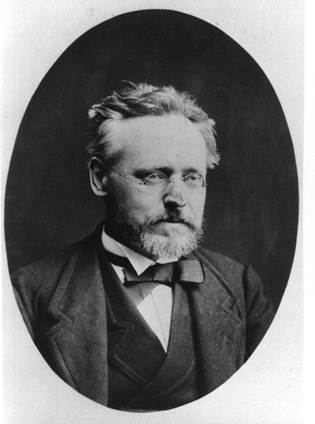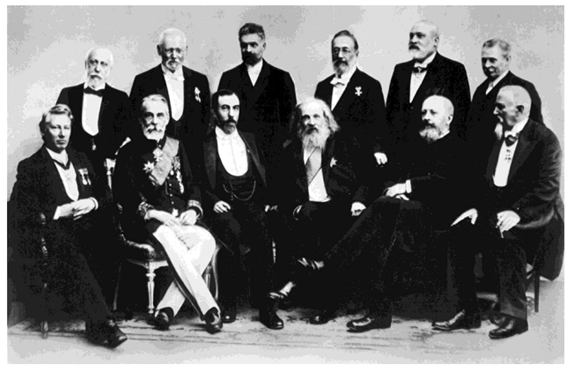INTRODUCTION
The important events in the Jørgensen's life
Sophus Mads Jørgensen (Figure 1) was called “an excellent experimental chemist” (Baran, 2015, p. 40) and “an excellent handyman working chemist” (Bostrup, 2005, p. 21). One hundred and seven years have passed since his death, but in that time very little has appeared in the literature about this very interesting man. One might agree at this point with the words of the American chemist and historian of chemistry George B. Kauffman (1930-1920), who wrote sixty-two years ago in his article in the Journal of Chemical Education that “except for those who have had occasion to delve into the study of complex compounds, the name of Sophus Mads Jørgensen remains entirely unknown” (Kauffman, 1959, p. 521). Nevertheless, it should be remembered that he went down in the history of chemistry, not only as a pioneer of the chemistry of complex compounds, but also as the author of many books, including a textbook published in various countries of the world.
Sophus Mads Jørgensen was born in Slagelse (Denmark) on July 4, 1837, and he was the son of Jens Jørgensen (1788-1862) and his wife Caroline, née Grønning (1794-1855) (Rancke-Madsen, n.d.).
At the age of nine, in 1846, he began his early education first at the Slaglese School and then, in 1852, at the Sorø akademi (Rancke-Madsen, n.d.). At this academy, he became interested in chemistry thanks to the classes conducted by the Danish chemist Frederic Johnstrup (1818-1894). After graduating from Sorø akademi in 1857, he entered the University at Copenhagen (Kauffman, 1959, p. 521).
In 1863, he received magistergrad i kemi (master's degree in chemistry) at the University (P. T. C., 1910, p. 496). One year later, he became Assistant of the Danish chemist Edvard August Scharling (1807-1866) at Polyteknisk Læreanstalt. In 1867, he was appointed Director of the Chemistry Laboratory at the Polytechnic (1867-1907). He taught there 41 years (1867-1908) (DTU Historie - og, n.d.).
In 1869, he defended his doctoral dissertation entitled Overjodider af Alkaloiderne (Polyiodides of Alkaloids) and received his Ph.D. (Jørgensen, 1869a). On November 10, 1871, he married Louise, neé Wellmann (1849-1921) (Rancke-Madsen, n.d.).
In the years 1871-1887, he was Lektor i kemi (Lecturer in Chemistry) at the Københavns Universitet (University of Copenhagen) (“DTU Historie - og”, n.d.). In 1887, he was appointed Professor of Chemistry (Kauffman, 1966, p. 30). He held this position for twenty-one years until his retirement in 1908. He died on April 1, 1914.
Jørgensen's participation in the scientific celebrations abroad
In 1900, Landolt took part in the Berlin conference devoted to the 200th Anniversary of the Königlich Preußischen Akademie der Wissenschaften (Royal Prussian Academy of Sciences). Figure 2 is a photography made during this celebration (200th Aniversary of Berlin, 1900). The American biochemists Benjamin Harrow (1888-1970) inserted this photo on the one of first pages of his book entitled Eminent Chemists of Our Time. He also wrote that it “showing several eminent chemists was taken at one of the international scientific gatherings” (Harrow, 1920, p. 8).
Photograph was published by Harrow thanks to the kindness of the Dutch chemist Ernst Julius Cohen (1869-1944) (Donnan, 1948). Jørgensen is standing second from the left; to his right is the German chemist and historian of chemistry Albert Ladenburg (1842-1911) (Sztejnberg, 2021b). To his left are the Finnish chemist and historian of chemistry Edvard Hjelt (1855-1921) (Kauffman & NiiNistö, 1998), the German chemist Hans Heinrich Landolt (1831-1910) (Oesper, 1945), the German chemist Clemens Alexander Winkler (1838-1904), who discovered germanium in 1886 (Volke, 2004), and the British chemist and historian of chemistry Sir Thomas Edward Thorpe (1845-1925) (Tutton, 1925). Seated from the left to right in the front row are van’t Hoff, the Russian - German chemist Friedrich Konrad Beilstein (1838-1906) (Sztejnberg, 2021a), the British chemist Sir William Ramsay (1852-1916), who found neon, argon, krypton, and xenon in air and was awarded the Nobel Prize in Chemistry in 1904 (Tilden, 1918), the Russian chemist Dmitri Ivanovich Mendeleev, who discovered the Periodic Law in 1871 (Boeck & Zott, 2007; Sztejnberg, 2018), the German chemist Adolf von Baeyer (1835-1917), who received the Nobel Prize in Chemistry in 1905 (Baeyer, Villiger, Hottenroth, & Hallensleben, 1905), and the Italian chemist Alfonso Cossa (1833-1902) (Kauffman & Molayem, 1990).
Jørgensen’s works
The list of Jørgensen’s works includes seventy-six papers (Bostrup, 2005, p. 21). Fifty of his papers from the years 1869 to 1905 presenting the results of his experimental studies have been published in German journals, mainly in Journal für praktische Chemie and Zeitschrift für anorganische Chemie (Wiley Online Library, 1999-2021).
In 1867, his article entitled Overjodider af Alkaloiderne (Polyiodides of Alkaloids) was published by the Kongelige Danske Videnskabernes Selskab (Royal Danish Academy of Sciences and Letters) (Jørgensen, 1867). Two years later, his paper Ueber einige Superjodide (About Some Super Iodides) appeared in Berichte der deutschen chemischen Gesellschaft (Jörgensen, 1869). He presented the results of his experimental studies on new chromium ammonia compounds in an article published in Danish in 1879 (Jørgensen, 1879).
In the years 1890-1899, he published a total of 11 articles in which he presented the results of his experimental studies on the composition of cobalt, chromium and rhodium complex compounds. Seven of his papers are available in the Wiley online Library (Jörgensen, 1890a; Jörgensen, 1890b; Jörgensen, 1892; Jörgensen, 1894a; Jörgensen, 1894b; Jörgensen, 1898; Jörgensen, 1899). For instance, in one of the articles, he reported the “discovery of the xantho (nitro) ([Co(NO2)(NH3)5]Cl2) and isoxantho (nitrito) ([Co(ONO)(NH3)5]Cl2) pentaammines of cobalt(III)” (Kauffman, Kauffman, & Gray, 2007, p. 4781; Jörgensen, 1894a).
In the period of 20 years, from 1885 to 1905, he conducted research on the constitution of various platinum complex compounds. The results of these studies were published in four articles (Jørgensen, 1885; Jørgensen, 1900a; Jørgensen, 1900b; Jørgensen, 1905). In 1900, he wrote an article about the two platinum compounds obtained by the Danish chemist William Christopher Zeise (1789-1847) and Alfonso Cossa (Jørgensen, 1900).
His last article available in the Wiley Online Library was written jointly with the Danish chemist Søren Peter Lauritz Sörensen (1868-1939). It was entitled Über eine neue, mit Magnus' grünem Salze isomere, rote Verbindung (About the New Red Isomeric Compound with Magnus' Green Salt [Pt (NH3)4.PtCl4]) (Jörgensen & Sörensen, 1905).
Jørgensen's books on chemistry and the history of chemistry
Most of Jørgensen's books and textbooks are written in Danish. Only a few have been translated into other languages or have been written in another language. His first book under the title Vejledning I De Uorganiske Stoffers Qvantitative Analyse (Guidance in the Quantitative Analysis of Inorganic Substances) was published after he obtained his Doctorate in Philosophy in 1869 (Jørgensen, 1869b).
The German chemist Leopold Gmelin (1788-1853) became very well-known through his Handbuch der Chemie. After his death, subsequent editions of the Handbuch der Chemie had focused on inorganic compounds only, leading to its retitling as Gmelins Handbuch der anorganischen Chemie. In 1875, Jørgensen was editor of the third volume, the sixth revised edition of the Gmelins Handbuch der anorganischen Chemie (Gmelin, 1875).
In 1871, Jørgensen wrote a book in German entitled Das Thallium. Eine Zusammenstellung der vorhandenen Beobachtungen (The Thallium. A Compilation of the Existing Observations). In the preface of May 7, 1871, he wrote:
“The numerous observations which have been made of this remarkable metal in the short time since thallium was discovered have not yet been compiled into a clear whole. While I was working on this chapter for the sixth edition of Gmelin's Handbook of Inorganic Chemistry, which is now to be published, I had many opportunities to gain the conviction that, although hardly any element has been worked so quickly as thallium, our knowledge of it relationships not only shows numerous gaps, but also a lot of contradicting information, which only become conspicuous through the compilation. I have therefore believed that a compilation of all the observations on thallium would be both generally welcome and perhaps also help to re-examine the many still questionable points” (p. 7).
In 1875, the first Danish edition of his Om den saakaldte Herapathit og lignende Acidperjodider (About the so-called Herapathite and similar Acid Periodides) was published by Bianco Lunos Bogtrykkeri in Copenhagen (Jørgensen, 1875).
The first Danish edition of his Kortfattet Chemi til Brug for Skoler (Brief Chemistry for Use in Schools) appeared in 1874 (Jørgensen, 1874). Two years later, an abridged edition of this book, Kemiens Begyndelsesgrunde til Brug for Skoler (Chemical Beginnings for Use in Schools), was published by Gad in Copenhagen (Jørgensen, 1876). A second reworked edition of this book appeared in 1885, a third in 1890, and a fourth in 1896.
The first Danish edition of his textbook entitled Lærebog I Organisk Chemi (Textbook in Organic Chemistry) (Figure 3) was published in 1880 (Jørgensen, 1880), and the second, in 1906.
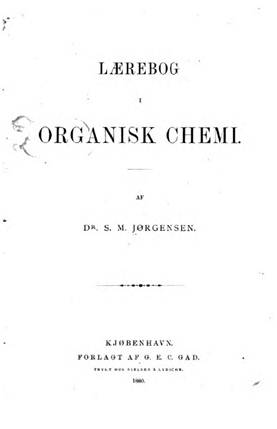
Fig. 3 Title page of S. M. Jørgensen's Lærebog I Organisk Chemi (Kjøbenhavn: Forlagt Af G. E. C. Gad, 1880).
In 1888, the first Danish edition of his textbook under the title Mindre Lærebog i uorganisk Chemi (Smaller Textbook in Inorganic Chemistry) was published in Copenhagen (Jørgensen, 1888). The second edition of this book appeared eight years later.
The first Danish edition of his elementary textbook entitled Kemiens Grundbergreber oplyste ved Exempler og simple Forsøg was published in 1902 in Copenhagen (Jørgensen, 1902). A second improved edition of this book appeared eleven years later.
The German (1903) edition of this textbook was published in Hamburg (Jörgensen, 1903), and an Italian one in 1904 in Turin. The translator was Mario Guareschi (Jörgensen, 1904). This textbook was also published in Greek in 1904 (Kauffman, 1959, p. 522; Bostrup, 2005, p. 21). The English (1908) edition under the title Manuals of Elementary Science. The Fundamental Conceptions of Chemistry appeared in London. The translator was the British chemist Malcolm Perseval Applebey (1884-1957) from Trinity College, Oxford (Jörgensen, 1908).
George B. Kauffman in his article (1959) wrote about this textbook as follows:
“Probably his most famous text is “Kemiens Grundbegreben” (Fundamentals of Chemistry), published in 1902. In less than 200 pages, Jørgensen gives not only a summary of the basic concepts of chemistry, but also a survey of its historical development” (p. 521).
The first Danish edition of his Om Iltens Opdagelse (the Discovery of Oxygen) was published in 1907 in Copenhagen. Figure 4 shows the title page of this book (Jørgensen, 1907).
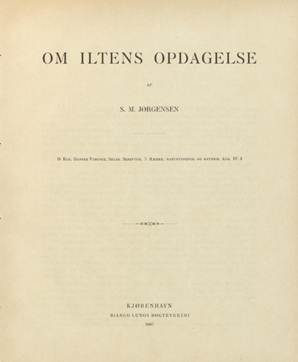
Fig. 4 Title page of S. M. Jørgensen's Om Iltens Opdagelse (Kjøbenhavn: Bianco Lunos Bogtrykkeri, 1907).
The first German edition of this book entitled Die Entdeckung des Sauerstoffes was published in 1909 in Stuttgart. The translators were Vilhelm Ortwed and Max Speter (Jörgensen, 1909). B. Neumann (1909) in a review of this book wrote:
“If it is interesting in and of itself to follow the development of some great discovery, an explanation of all those details connected with the discovery of oxygen must attract all the more interest to every chemist, because this discovery is all the more interesting for all those of that time overturned chemical notions and laid the foundations for the development of modern chemistry. Jörgensen researched the relevant sources with great diligence and embarrassing conscientiousness and draws a vivid picture of the progressive knowledge of the existence, the behavior, the effect and finally the production of oxygen”(p. 816).
A surviving manuscript of Jørgensen's book entitled Det Kemiske Syrebegrebs Udviklingshistorie Indtil 1830 (The Developmental History of the Chemical Acid Concept until 1830) was published two years after his death by Ove Jørgensen and S. P. L. Sørensen (Jørgensen, 1916). It was re-released in 1918.
CONCLUSION
Sophus Mads Jørgensen (1837-1914) was one of the leading chemists of the second half of the XIX century and the first decade of the XX century. He achieved tremendous success in his life. He was one of the founders of the chemistry of complex compounds. He also made major contributions to the chemistry of platinum, cobalt, chromium and rhodium compounds. In 1874, he was elected a Member of the Royal Danish Society of Sciences and Letters. In the years 1885-1914, he was a Board Member of the Carlsberg Foundation. In 1886-1914, he was Member of the Executive Board of the Society for the Propagation of Natural Science (Rancke-Madsen, n.d.). In 1906, he received both the Bertholet Medal awarded by the l'Académie Française des Sciences (French Academies of Sciences) and the Lavoisier Medal given to him by the Société chimique de France (Chemical Society of France). ((O. C.). R. K., 1915-1930)).
He was one of the 30 chemists nominated for the Nobel Prize in 1907. The nominators were the French chemist Henri Moissan (1852-1907), Nobel Laureate in Chemistry in 1906, and the French mathematician Gaston Darboux (1842-1917), member of the Royal Swedish Academy of Sciences (The Nobel Prize, 2021a). However, the Nobel Prize went to the German biochemist Eduard Buchner (1860-1917) “for his biochemical researches and his discovery of cell-free fermentation” (“The Nobel Prize”, 1907). His books were written in Danish and German. Some of them have been translated into German, and his elementary textbook Kemiens Grundbergreber oplyste ved Exempler og simple Forsøg was published in Denmark, Germany, Great Britain, Greece and Italy. Some authors also wrote about his life and work. For instance, he as a resercher is often mentioned in a book edited by the Danish historian of science Helge Kragh and published in 1994 in Copenhagen (Kragh, 1994a). Kragh also described his controversy with the Swiss chemist Alfred Werner (1866-1919) (Kragh, 1994b; Kragh, 1997), who was awarded the Nobel Prize in Chemistry in 1913 for “recognition of his work on the linkage of atoms in molecules by which he has thrown new light on earlier investigations and opened up new fields of research especially in inorganic chemistry.” (The Nobel Prize, 2021b). Werner in his Nobel Lecture entitled On the constitution and configuration of higher-order compounds (Alfred Werner Nobel, 2021) wrote:“For further progress in the knowledge of the constitution of metal ammonias we are again indebted to a Nordic scientist, i.e. the Danish chemist S. M. Jorgensen, who extended and deepened the field of metal ammonias by researches which have become classic. Jorgensen showed that the formulae containing double metal atoms are untenable, and that not only one, but two acid residues can be directly linked with the metal atom. He was further able to show that on the departure of one molecule ammonia from the compounds richest in ammonia - which always contain six ammonia molecules for one metal atom, and in which all the acid residues are in loose linkage - one acid residue, and, on departure of two ammonia molecules, two acid residues enter into direct bond with the metal atom” (p. 257). The Danish chemist Børge Riis Larsen wrote about him as the author of the textbook in his book published by the Dansk Selskab for Historisk Kemi (Danish Society of the History of Chemistry) in 1998 (Riis Larsen, 1998). Jørgensen's experiments for use in schools were introduced to the readers by the Danish chemist Ole Bostrup (1934-2012) (Bostrup, 2003; Bostrup, 2005). George B. Kauffman wrote several articles about him and his research activities (Kauffman, 1959; Kauffman, 1992) as well as the Werner-Jørgensen Controversy (Kauffman, 1960; Kauffman, 1975a) and his correspondence with his friend the Swedish chemist Christian Wilhelm Blomstrand (1826-1897) from 1870 to 1897 (Kauffman, 1977). Blomstrand's chain theory was “developed and modified” by Jørgensen and “was for more than two decades the most popular and successful method of accounting for the structure, properties, and reactions of coordination compounds” (Kauffman, 1975b, p. 14). Kauffman, in one of his articles published in 1970, illustrated with examples the contrast between the Blomstrand-Jørgensen chain theory and the Werner coordination theory (Kauffman, 1970, p. 248). His biographical note written by Russians historians of chemistry was published in their book entitled Vydayushchiyesya Khimiki Mira. Biograficheskiy spravochnik (Outstanding Chemists of the World. Biographical Reference Book) in 1991 (Volkov, Vonskiy, & Kuznetsova, 1991). The Argentine chemist Enrique José Baran wrote about his life and work as well as about Blomstrand's “Chain Theory”, which he developed (Baran, 2015, pp. 40-41, 47-48).
After Jørgensen, not only his papers, textbooks and books survived. In addition, apart from a few of his photos (Den Store Danske, n.d.; Kauffman, 1992, p. 217; Zwisler & Buhl, 2021), there are two oil paintings by the Danish painter Peder Severin Krøyer (1851-1909), which show his likeness. The first one (Figure 4) was painted in 1897. It is the monumental group painted portrait entitled A Meeting of the Royal Danish Academy of Sciences [Height: 266.7 cm (105 in); Width: 519.4 cm (17 ft)], which can be seen in the Old Meeting Room on the first floor of the house belonging to Carlsberg Foundation in Copenhagen (The Carlsberg Foundation’s, n.d.; P.S. Krøyers maleri, n.d.). Counting from the left side of the people seated at the round table, Jorgensen is sitting eleventh in the middle of the table. On his right is the Danish classicist Johan Louis Ussing (1820-1905), and on the left - the Danish linguist Ludvig Vimmer (1839-1920) (Et Møde i, 1897).
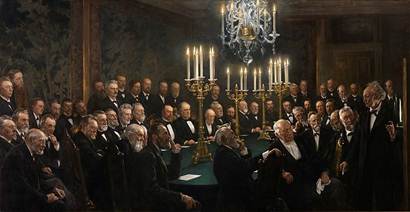
Fig. 5 Jørgensen at the Meeting of the Royal Danish Academy of Sciences (“Peder Severin Krøyer”, 1897).
The second Krøyer's group portrait [Height: 115.5 cm (45.4 in); Width: 184.5 cm (72.6 in)] is called Industriens Mænd (Men of Industry). It was painted in 1903/1904. In the front part of the painting, Jorgensen is standing in a circle of 10 people, third from the left (Men of Industry, 2021).
In addition to photos and oil paintings with Jørgensen, his bust was made by the Danish sculptor August Vilhelm Saabye (1823-1916) in 1898. It is now located at the Danmarks Tekniske Universitet (Technical University of Denmark). His collection of over 600 glasses with colorful coordination compounds is also stored there (Zwisler & Buhl, 2021; Object Record. Kompleksforbindelser, n.d.), as well as various measuring instruments from his chemical laboratory (“DTU Historie - og”, n.d.).
Jørgensen, as one of the outstanding masters of the chemistry of complex compounds, went down in the history of chemistry, and his name was written in it forewer. This was made possible thanks to his wonderful experimental studies, in which he obtained numerous complex compounds of platinum, cobalt, chromium and rhodium, his textbooks on organic and inorganic chemistry as well as his books on the history of chemistry.













